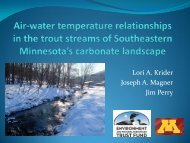Minnesota Water Resources Conference - Water Resources Center ...
Minnesota Water Resources Conference - Water Resources Center ...
Minnesota Water Resources Conference - Water Resources Center ...
You also want an ePaper? Increase the reach of your titles
YUMPU automatically turns print PDFs into web optimized ePapers that Google loves.
Concurrent Sessions V 1:15–2:45<br />
Track A: Lower <strong>Minnesota</strong> TMDL<br />
BOOK OF ABSTRACTS<br />
Wednesday, Tuesday, October 24 28 23<br />
Bridge Over Troubled <strong>Water</strong>s: Lower <strong>Minnesota</strong> River Model<br />
Catherine Larson, Metropolitan Council, Cathy.Larson@metc.state.mn.us<br />
The <strong>Minnesota</strong> River carries high nutrient and sediment loads as it flows through one of only four national<br />
wildlife refuges in a metropolitan area. The lower reach experiences stress from a large agricultural watershed<br />
to the west and rapidly expanding urban area to the east. Two large modeling efforts are addressing<br />
impairments upstream of Jordan and downstream in the Mississippi River, leaving a 40-mile gap in the lower<br />
<strong>Minnesota</strong> River. The Metropolitan Council coordinated a six-year project with federal, state, and local partners<br />
to develop a water-quality model to fill the gap. The partners designed a comprehensive monitoring program<br />
to support the model, including biweekly sampling of the river, tributaries, and discharges over three years.<br />
Intensive monitoring was added at low summer flows to capture critical conditions. To support specific model<br />
settings, we conducted special studies of oxygen, phytoplankton, nutrient, and sediment dynamics. An overview<br />
and results will be presented.<br />
Phosphorus Dynamics and Loading in the Turbid <strong>Minnesota</strong> River (USA): Controls and Recycling<br />
Potential<br />
William James, U.S. Army Engineer Research and Development <strong>Center</strong>, William.F.James@erdc.usace.army.mil; Catherine E.<br />
Larson, Metropolitan Council<br />
Phosphorus dynamics were examined in the lower 40-mile reach of the <strong>Minnesota</strong> River in relation to hydrology,<br />
loading sources, suspended sediment, and chlorophyll to identify biotic and abiotic controls over soluble<br />
phosphorus (SRP) and the recycling potential of particulate phosphorus (PP) during transport to the Upper<br />
Mississippi River. Wastewater treatment plant contributions as SRP were greatest during low flows and declined<br />
with increasing flow and nonpoint source phosphorus loading. SRP declined during low flow in conjunction<br />
with increases in chlorophyll, suggesting transformation to PP via phytoplankton uptake. During higher flows,<br />
SRP was constant at 0.115 mg/L and coincided with an independently measured equilibrium P concentration<br />
for suspended sediment in the river. PP accounted for ~66% while redox-sensitive PP, estimated using extraction<br />
procedures, represented 43% of the annual PP load. Recycling potential of this load via anoxic diffusive<br />
phosphorus flux was estimated as ~17 mg m -2 d -1 using published regression equations.<br />
Modeling the Hydrodynamics and <strong>Water</strong> Quality of the Lower <strong>Minnesota</strong> River Using CE-QUAL-W2<br />
David Smith, U.S. Army Engineer Research and Development <strong>Center</strong>, David.L.Smith@usace.army.mil; Tammy Threadgill, U.S.<br />
Army Engineer Research and Development <strong>Center</strong>; Barry Bunch, U.S. Army Engineer Research and Development <strong>Center</strong>;<br />
Catherine Larson, Metropolitan Council<br />
The U.S. Army Engineer Research and Development <strong>Center</strong> with assistance from the Metropolitan Council<br />
and partners developed a water-quality model of the lower <strong>Minnesota</strong> River, Jordan to the mouth, using the<br />
2-D laterally averaged CE-QUAL-W2 model (version 3.5). The objective was to produce a water-quality model<br />
that could be used to forecast changes in water quality as a function of management actions. Our approach<br />
was to develop a comprehensive database of hydrodynamic (discharge, elevation, and temperature) and waterquality<br />
(total dissolved solids, inorganic suspended solids, phosphate, ammonia, nitrate, silica, biological<br />
oxygen demand, three algal groups, and dissolved oxygen) data to assess model performance. Performance was<br />
measured with correlation coefficients, mean error, root mean square error, and absolute mean error statistics<br />
at eight longitudinal locations in the river. Model performance demonstrates that the CE-QUAL-W2 model is a<br />
sound tool for assessing and forecasting water-quality impacts of management actions in the watershed.<br />
<strong>Minnesota</strong> <strong>Water</strong> <strong>Resources</strong> <strong>Conference</strong>, October 27–28, 2008 68
















